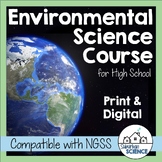Environmental Science Unit: Urbanization, Sustainable Forestry & Agriculture
- Zip
What educators are saying
Also included in
- These environmental lesson plans will help your students to take charge of their learning! This comprehensive course is interactive, hands-on, and student-centered! Students learn about major environmental issues in modern society through detailed lessons and activities. Units cover the four sphePrice $250.00Original Price $276.00Save $26.00
Description
This comprehensive set of lessons and activities will introduce your students to the topics of land use and sustainability in regard to urbanization, agriculture, and forestry. Human impacts on the environment are interwoven through each lesson to provide students with a good basis for any environmental science or APES course. A PowerPoint, guided notes, web-quests, doodle notes, activities, extension pages, and assessments are all included in this lesson. All student pages come in both PRINT and DIGITAL versions for efficient use in class or through distance learning.
➤PLEASE NOTE: This unit is also included in my FULL ENVIRONMENTAL SCIENCE CURRICULUM.
➤What's included?
-10 Teacher Planning Pages (standards document, editable daily pacing guide, differentiation ideas for student interest, ability, and learning environment)
-1 PowerPoint (51 editable slides- highly visual and fully animated)
-6 pages of Cornell Notes (both fill-in-the-blank and editable versions included)
-3 web-quests with corresponding student pages for independent learning
-3 pages of my popular Doodle Notes(TM) and a guide to using them in your classroom
-10 Activities:
- 2 research activities (Urban Sprawl, Forest Pest Management)
- 3 group activities (Impacts of Urbanization Poster, Be A City Planner, What's the Value of a Tree?)
- 3 independent activities (Heat Islands, Urban Issues in Developing & Developed Countries, Information Flyer on Protein Sources)
- 2 whole-class activities (Debate: GMOs, Perplexed by Protein Graph Interpretation)
-9 Extension Pages:
- 5 Digging Deeper extensions for increased depth of knowledge & critical thinking skills (Water Shortages, Road Design, Impacts of Timber Harvesting, Forest Protection, Noise Pollution)
- 4 Data Analysis extensions to focus on interpretation of graphs & math integration (Urban Air Pollution, Urban v. Rural Health Issues, Global Seed Vault, Effects of Supply Chain)
-2 quizzes through Google Forms for automatic online grading
-24 editable task cards for a quick and easy unit review
-Editable unit test with multiple-choice and short answer questions (in both honors and regular versions)
-Supplementary Resource Ideas: links and videos for additional explanation or exploration
-Answer keys and grading rubrics for all student pages
➤What topics are included in this unit?
Urbanization & Land Use
- Euclidian zoning
- Development of villages & cities from hunting & gathering
- Environmental impacts of cities (air pollution, water pollution, noise pollution, light pollution)
- Human health impacts of cities (obesity from commuting, sanitation issues in developing countries
- Heat islands
- Urban sprawl
- City planning and smart growth
Sustainable Forestry
- What is sustainability?
- 3 E's of sustainability (economics, environment, equity)
- Economic and environmental benefits of trees
- Finding the timber value of a tree
- Deforestation and reforestation
- Habitat fragmentation and wildlife corridors
Sustainable Agriculture
- The Green Revolution
- Agricultural impacts on the environment
- Sustainable practices in agriculture
- Organic v. traditional farming
- Vertical farming and other future agricultural techniques
- Genetically modified organisms (GMOs)
- Impacts of various protein sources on the environment
The unit is aligned to NGSS and many state standards. If you’d like to know whether your state standards are covered, you can send me an email at support@suburbanscience.com.
NGSS addressed in this unit: HS-ESS2-2, HS-ESS2-6, HS-ESS3-1, HS-ESS3-3, HS-ESS3-4, HS-ESS3-5, HS-ESS3-6, HS-ETS1-1, HS-ETS1-2, HS-ETS1-3, HS-LS2-2, HS-LS2-4, HS-LS2-5, HS-LS2-6, HS-LS2-7. Additional details on standards are included in the teacher planning pages of this course.
________________________________________________________________________
*For more details about the specific topics and items included, please see my PREVIEW.*
➤Where can I find other Environmental Science lessons?
Intro to Environmental Science
Biosphere Unit 1: Ecology, Food webs, and Symbiosis
Biosphere Unit 2: Species and Population Ecology
Biosphere Unit 3: World Biomes, Ecological Succession, and Biodiversity
Atmosphere: Weather, Wind, and Biogeochemical Cycles
Geosphere Unit 1: Plate Tectonics and Landforms
Geosphere Unit 2: Minerals, Mining, and Soil
Geosphere Unit 3: Fossil Fuels and Renewable Energy
Hydrosphere Unit 1: Surface Water, Groundwater, and the Water Cycle
Hydrosphere Unit 2: Marine Biomes and Water Pollution
Or get the Full Environmental Science Curriculum which includes all these units!
➤What curriculum could I use with this lesson?
This lesson is ideally geared toward high school students and would work well with a general-level Environmental Science or Biology textbook. It addresses the following topics in AP Environmental Science (APES):
- 5.1 The Tragedy of the Commons
- 5.2 Clearcutting
- 5.3 The Green Revolution
- 5.4 Impact of Agricultural Practices
- 5.5 Irrigation Methods
- 5.6 Pest Control Methods
- 5.8 Sustainable Agriculture
- 5.10 Impacts of Urbanization
- 5.12 Introduction to Sustainability
- 5.17 Sustainable Forestry
- 7.8 Noise Pollution
- 9.10 Human Impacts on Biodiversity
➤Can I edit these resources to fit my needs?
Some of the files in this unit are editable. The text on the PowerPoints, Cornell Notes, and task cards is all editable so you can adjust the level of content and wording. The pacing guide, printable unit tests, and online quizzes through Google Forms™ are all fully editable. Web-quests, activities, extension pages, and any images included in this unit are in non-editable PDF formats to protect my intellectual property rights and those of the illustrators whose images I’ve purchased for use in this resource.
______________________________________________________________________________
⭐For updates about sales and new products, please follow my store: My TpT Store
You can also
⭐Subscribe to my newsletter for freebies and teaching tips
⭐Follow me on Instagram
⭐Check out my Facebook page
⭐Follow me on Pinterest
I value your feedback. Please rate this product. If you have any issues or questions about this product, please feel free to ask a question in my store or write to me at support@suburbanscience.com.






